113 Painting Rack 8


Barre Academy
Name/Title
Barre Academy
Description
"Barre Academy," by James Franklin Gilman, 1873. Charcoal and white gauche on brown paper. Depicts building with mansard roof and a smaller. Greek Revival building. Right center-many people clustered around it. The left center shows a large gabled house or top of a hill. There is a road which runs betwee the rwo buildings, several horses and carriages on the road.
Acquisition
Accession
2014.60
Relationships
Related Person or Organization
Spaulding, Jacob Shedd (1811-1880)
Person or Organization
Artwork Details
Medium
Charcoal, Gouache, Paper
Subject
Barre Academy
Made/Created
Artist Information
Gilman, James Franklin (1850-1929)
Artist
Date made
1873
Dimensions
Width
30-1/4 in
Height
21 in
Entry/Object ID
2014.60.1314
Type of Drawing
Context
This drawing by itinerant artist James Gilman depicts the Barre Academy (1852-1885) and boarding house. This private school was removed from the site to make way for Spaulding Graded School, the city's new public school, which opened in 1892. The new graded school was named after Jacob Spaulding (1811-1880), the longtime principal of Barre Academy. Spaulding Graded school became Spaulding High School and later middle school - ultimately closing in 1995. It's now the home of the Vermont History Center. Spaulding Graded School was built on the site of the boarding house seen to the right composition and the academy site is now the front lawn and approach to the institution.
James Franklin Gilman was born in 1850 in Woburn, Massachusetts to John and Elizabeth Gilman. His father was a cordwainer and his mother a seamstress. Early census records indicate his mother was born in Vermont. Little is known of his early life or education.
By the late 1860s he evidently made his living as an itinerant artist, often depicting the farm landscape and/or portraits of those providing him with room and board. Works remain of farms and people in Chelmsford, Groton, and Billerica, MA.
In 1872 he arrived in Barre, Vermont, a tall man with red hair and a distinctive red beard. He spent over twenty years in the general vicinity of Barre, Montpelier, Plainfield, and Calais. Most of the time was spent boarding with various farm families, though he did open a studio and school in Montpelier for a time.
At some point in the late 1880s or early 1890s he joined the Church of Christian Scientists and became acquainted with church found Mary Baker Eddy. He ultimately sold all of his works and the contents of his studio, some say in reaction to a lost love, and moved back to Massachusetts. He famously illustrated a poem entitled "Christ and Christmas" by Eddy.
The last decade of his life was spent in Athol, MA were he lived on the edge of poverty.
James Franklin Gilman was born in 1850 in Woburn, Massachusetts to John and Elizabeth Gilman. His father was a cordwainer and his mother a seamstress. Early census records indicate his mother was born in Vermont. Little is known of his early life or education.
By the late 1860s he evidently made his living as an itinerant artist, often depicting the farm landscape and/or portraits of those providing him with room and board. Works remain of farms and people in Chelmsford, Groton, and Billerica, MA.
In 1872 he arrived in Barre, Vermont, a tall man with red hair and a distinctive red beard. He spent over twenty years in the general vicinity of Barre, Montpelier, Plainfield, and Calais. Most of the time was spent boarding with various farm families, though he did open a studio and school in Montpelier for a time.
At some point in the late 1880s or early 1890s he joined the Church of Christian Scientists and became acquainted with church found Mary Baker Eddy. He ultimately sold all of his works and the contents of his studio, some say in reaction to a lost love, and moved back to Massachusetts. He famously illustrated a poem entitled "Christ and Christmas" by Eddy.
The last decade of his life was spent in Athol, MA were he lived on the edge of poverty.
Web Links and URLs


Going to Meeting
Name/Title
Going to Meeting
Type of Painting
Description
Winter landscape. With white church in right middleground. Six figures (one left, one center, two right center, two right) move toward the church. Black picket fence goes from left to center. Snow covered trees in background.
Relationships
Related Publications
Memories Touched by Fancy
Publication
Artwork Details
Medium
Oil
Made/Created
Artist Information
Drennan, Bessie Maria (1882-1961)
Artist
Date made
1950
Dimensions
Width
21-1/2 in
Height
17 in
Entry/Object ID
VHS-A-496
Context
Bessie Drennan, a lifelong resident of Woodbury, Vermont, started painting near the end of her life. Her scenes, in the folk or naive style, became quickly collectible by locals and visitors alike. Though she produced her artwork at the same time as Grandma Moses, she never reached her level of fame.
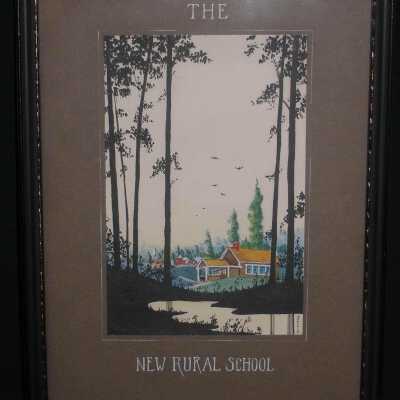

New Rural School
Name/Title
New Rural School
Description
Watercolor of a rural school house with trees and fields in foreground and a village in the background. It is mounted within a brown mat that has the label, "THE NEW RURAL SCHOOL" and a thin silver line around the mat opening. The whole is framed in a black wooden frame with a simple molding.
Acquisition
Accession
2003.64
Relationships
Related Person or Organization
Farnham, Lenora Rachael Stevens (1869-1943), Daughters of the American Revolution
Artwork Details
Medium
Watercolor
Made/Created
Artist Information
Stebbins, Verna Adele (1898-1998)
Artist
Painter
Role
Date made
1924
Dimensions
Width
8-3/8 in
Height
12 in
Entry/Object ID
2003.64.1
Context
In the late 1910s and 1920s the Daughters of the American Revolution took a distinct interest in education in the United States. In the early years they felt a need to create a unified, Anglo-American-centric curriculum to help immigrants shed their own culture and become "Americanized." By the mid-1920s this initiative grew beyond new immigrants to poor and rural schools.
In 1924, the Marquis de Lafayette Chapter of the DAR (Montpelier) sponsored a speaking contest to define the "New Rural School" and raise funds for the project. The speaker had to be between the ages of 50 and 90. This second prize painting by Verna Stebbins of Montpelier was awarded to Lenora Stevens Farnham on February 24, 1924.
In 1924, the Marquis de Lafayette Chapter of the DAR (Montpelier) sponsored a speaking contest to define the "New Rural School" and raise funds for the project. The speaker had to be between the ages of 50 and 90. This second prize painting by Verna Stebbins of Montpelier was awarded to Lenora Stevens Farnham on February 24, 1924.
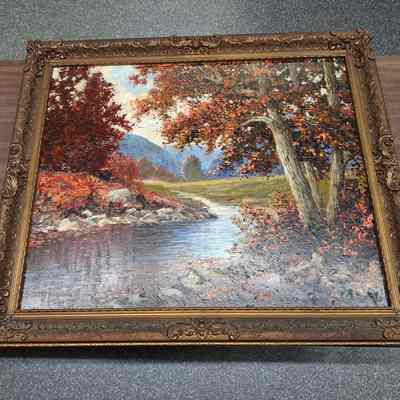

Painting
Name/Title
Painting
Type of Painting
Description
Painting of the Ottauquechee River by George Forrest Payne. The foreground shows a bend in the river with rocky banks and trees tinged with red and orange autumn colors in the middle ground. The river bends away through the middle and background amidst green fields with mountains in the background. It resides in an ornate carved gilt frame.
Acquisition
Accession
2024.39
Relationships
Related Person or Organization
Payne, George Forrest
Person or Organization
Artwork Details
Medium
Oil
Subject
Ottauquechee River
Made/Created
Artist Information
George Forrest Payne
Artist
Dimensions
Width
37-1/4 in
Height
31-1/4 in
Entry/Object ID
2024.39.1
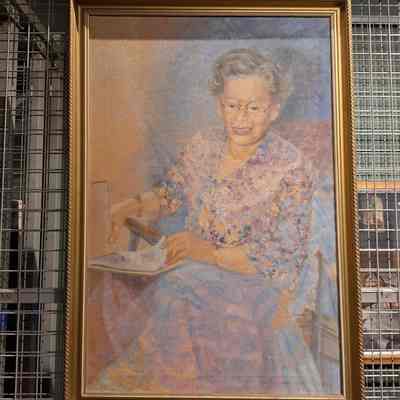

Portrait
Name/Title
Portrait
Type of Painting
Description
Portrait of Gertrude Croker. Croker has short, slightly curled grey/silver hair, glasses, send is smiling at someone outside the frame of the image. She wears a gold necklace and watch, a floral v-neck blouse and periwinkle skirt. She sits in a pale blue chair holding a sketchbook, all in front of a multicolored pastel background. The painting resides in a simple gold frame with carved corded outer border.
Acquisition
Accession
2024.16
Relationships
Related Person or Organization
Austine School for the Deaf
Croker, Gertrude (1881-1994)
Artwork Details
Medium
Oil
Subject Person
Croker, Gertrude (1881-1994)
Dimensions
Width
27-1/2 in
Height
39-1/2 in
Entry/Object ID
2024.16.63
Context
Though born in Iowa, Gertrude Croker moved to Newfane, Vermont when she was 6 months old. Her family traced their roots back generations to southeast Vermont. She attended school in Newfane and graduated from Brattleboro High School in 1900. She decided to become a teacher of the deaf due to her own hearing impairment (tone deafness).
She attended the Clarke School in Northhampton, Massachusetts for a year and then started teaching at the Lexington School for the Deaf in New York City. In 1912 she moved to the Manhattan School for the Deaf where she taught until her retirement in 1946. In 1914 she wrote a series of books and workbooks for teaching language skills. These works were translated into a number of languages and can still be purchased today.
Upon her retirement, she moved back to Brattleboro, where she became involved with the Austine School for the Deaf. She lived a remarkably long life, passing away at the age of 113. At the time of her death she was believed to be the oldest Vermont resident.
This portrait of her hung at the Austine School for the Deaf until its closure.
She attended the Clarke School in Northhampton, Massachusetts for a year and then started teaching at the Lexington School for the Deaf in New York City. In 1912 she moved to the Manhattan School for the Deaf where she taught until her retirement in 1946. In 1914 she wrote a series of books and workbooks for teaching language skills. These works were translated into a number of languages and can still be purchased today.
Upon her retirement, she moved back to Brattleboro, where she became involved with the Austine School for the Deaf. She lived a remarkably long life, passing away at the age of 113. At the time of her death she was believed to be the oldest Vermont resident.
This portrait of her hung at the Austine School for the Deaf until its closure.
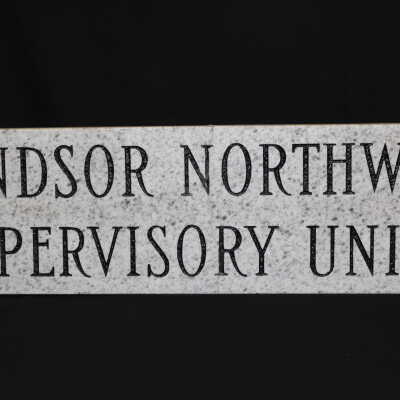

Sign
Name/Title
Sign
Description
Granite sign. Inscribed text reads,"Windsor Northwest / Supervisory Union" in black. There are two iron eye bolts cemented into the top corners of the sign. There is a crack at the top middle of the sign.
Acquisition
Accession
2016.18
Made/Created
Date made
1980-2016
Dimensions
Height
8-1/4 in
Depth
1 in
Length
34 in
Materials
Material
Granite
Entry/Object ID
2016.18
Context
This granite sign represented the former Windsor Northwest Supervisory Union, a school administrative district that dissolved on June 30, 2016. The district combined with the Orange-Windsor Supervisory Union to become the White River Valley Supervisory Union.
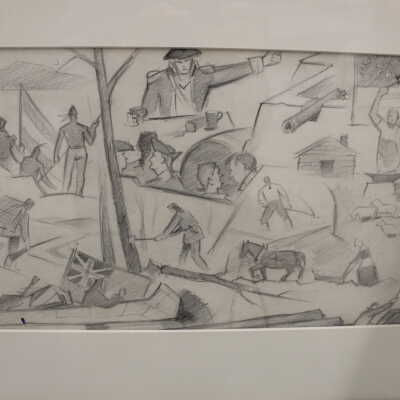

Tribute to Vermont (study 1)
Name/Title
Tribute to Vermont (study 1)
Description
In the far left corner there is a scene of Native Americans paddling a canoe, and to their left is Samuel de Champlain. To the right of the Native American scene is a picture of a man with his fist raised wearing a colonial hat. Below him there is a man chopping wood and two horses plowing a field. To the right there is a drawing of a lake, next to the lake there is a drawing of a man on a horse. Below this man is an older man holding a piece of paper above the state house. To the right of the state house there is a scene of sap collecting. Two trees frame this scene. To the right of the sap scene there is a drawing of a man holding a gavel above a group of people. To the right of the group is a scene of a granite quarry. To the right of the granite quarry there is a drawing of a college graduation. Below the college drawing is a drawing of people skiing.
Acquisition
Accession
2016.39
Artwork Details
Medium
Pencil
Made/Created
Artist Information
Sample, Paul Starrett (1896-1974)
Artist
Date made
2016
Dimensions
Height
14-1/8 in
Length
55-3/4 in
Entry/Object ID
2016.39.2
Type of Drawing
Context
When National Life laid the cornerstone of its headquarters on the ridge overlooking Montpelier in 1958, their CEO approached well-known-muralist Paul Sample to create an iconic work of art to evoke the past, present, and future of Vermont as a centerpiece of the new structure. Sample worked closely with National Life to choose scenes and topics that reflected both Vermont's story and that of the company's rich Vermont roots. As he got closer to a final design, Sample produced scale drawings, called cartoons, of the mural in both pencil and paint for company approval. When he was ready to transfer the design to the full eight by fifty-foot canvas, he partitioned the final cartoon into numbered blocks to ease the enlargement of scenes. Notice how the composition and content of the mural changed from the bottom sketch to the top working design.
Paul Starrett Sample (September 14, 1896 – February 26, 1974) was an American artist who portrayed life in New England in the middle of the 20th Century with a style that showed elements of "Social Realism and Regionalism."
Sample was born in Louisville, Kentucky in 1896. After having moved across the country with his family on several occasions, Sample attended Dartmouth College in Hanover, New Hampshire. There he studied architecture and graduated in 1921 after a year in the Naval Reserve during World War I. While visiting his brother, Donald, at a sanatorium in Saranac Lake, New York, Sample contracted tuberculosis. He stayed for treatment of that disease in Saranac Lake for four years. There he met Sylvia Howland, whom he married in 1928.
At Saranac Lake, Sample studied drawing and painting under Jonas Lie. He then studied at the Art Students League of Los Angeles, and the Otis Art Institute in Los Angeles, California. There his work reflected social issues connected with the Great Depression with two noted paintings in 1931. In 1926 Sample joined the faculty of the University of Southern California in the school of architecture, where he remained until 1938. In 1938, he returned to New Hampshire to become the artist in residence at Dartmouth College, a position which he held until 1962. In addition to his social and regional paintings, Sample produced artwork for various magazines during World War II.
Paul Starrett Sample (September 14, 1896 – February 26, 1974) was an American artist who portrayed life in New England in the middle of the 20th Century with a style that showed elements of "Social Realism and Regionalism."
Sample was born in Louisville, Kentucky in 1896. After having moved across the country with his family on several occasions, Sample attended Dartmouth College in Hanover, New Hampshire. There he studied architecture and graduated in 1921 after a year in the Naval Reserve during World War I. While visiting his brother, Donald, at a sanatorium in Saranac Lake, New York, Sample contracted tuberculosis. He stayed for treatment of that disease in Saranac Lake for four years. There he met Sylvia Howland, whom he married in 1928.
At Saranac Lake, Sample studied drawing and painting under Jonas Lie. He then studied at the Art Students League of Los Angeles, and the Otis Art Institute in Los Angeles, California. There his work reflected social issues connected with the Great Depression with two noted paintings in 1931. In 1926 Sample joined the faculty of the University of Southern California in the school of architecture, where he remained until 1938. In 1938, he returned to New Hampshire to become the artist in residence at Dartmouth College, a position which he held until 1962. In addition to his social and regional paintings, Sample produced artwork for various magazines during World War II.
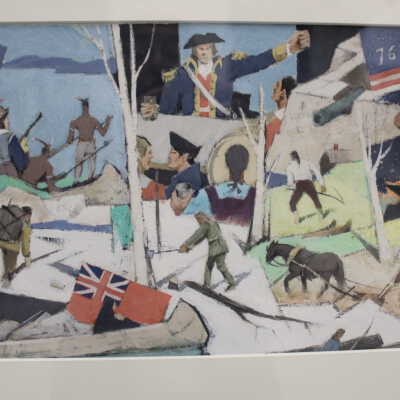

Tribute to Vermont (study 2)
Name/Title
Tribute to Vermont (study 2)
Type of Painting
Description
"Tribute to Vermont' by Paul Sample. A mural that measures 50' L x 8' H and depicts three-and-a-half centuries of Vermont history, from Samuel de Champlain's arrival in the Champlain Valley in 1609 to the development of Vermont's ski industry in the late 1950's." Same description as VHS-A-1153, however it is in color using colored pencil.
This is an acrylic study of the above mural, which is now housed in the Vermont History Museum in Montpelier.
This is an acrylic study of the above mural, which is now housed in the Vermont History Museum in Montpelier.
Acquisition
Accession
2016.39
Artwork Details
Medium
Acrylic
Made/Created
Artist Information
Sample, Paul Starrett (1896-1974)
Artist
Date made
2016
Dimensions
Height
14-1/8 in
Length
55-3/4 in
Entry/Object ID
2016.39.3
Context
When National Life laid the cornerstone of its headquarters on the ridge overlooking Montpelier in 1958, their CEO approached well-known-muralist Paul Sample to create an iconic work of art to evoke the past, present, and future of Vermont as a centerpiece of the new structure. Sample worked closely with National Life to choose scenes and topics that reflected both Vermont's story and that of the company's rich Vermont roots. As he got closer to a final design, Sample produced scale drawings, called cartoons, of the mural in both pencil and paint for company approval. When he was ready to transfer the design to the full eight by fifty-foot canvas, he partitioned the final cartoon into numbered blocks to ease the enlargement of scenes. Notice how the composition and content of the mural changed from the bottom sketch to the top working design.
Paul Starrett Sample (September 14, 1896 – February 26, 1974) was an American artist who portrayed life in New England in the middle of the 20th Century with a style that showed elements of "Social Realism and Regionalism."
Sample was born in Louisville, Kentucky in 1896. After having moved across the country with his family on several occasions, Sample attended Dartmouth College in Hanover, New Hampshire. There he studied architecture and graduated in 1921 after a year in the Naval Reserve during World War I. While visiting his brother, Donald, at a sanatorium in Saranac Lake, New York, Sample contracted tuberculosis. He stayed for treatment of that disease in Saranac Lake for four years. There he met Sylvia Howland, whom he married in 1928.
At Saranac Lake, Sample studied drawing and painting under Jonas Lie. He then studied at the Art Students League of Los Angeles, and the Otis Art Institute in Los Angeles, California. There his work reflected social issues connected with the Great Depression with two noted paintings in 1931. In 1926 Sample joined the faculty of the University of Southern California in the school of architecture, where he remained until 1938. In 1938, he returned to New Hampshire to become the artist in residence at Dartmouth College, a position which he held until 1962. In addition to his social and regional paintings, Sample produced artwork for various magazines during World War II.
Paul Starrett Sample (September 14, 1896 – February 26, 1974) was an American artist who portrayed life in New England in the middle of the 20th Century with a style that showed elements of "Social Realism and Regionalism."
Sample was born in Louisville, Kentucky in 1896. After having moved across the country with his family on several occasions, Sample attended Dartmouth College in Hanover, New Hampshire. There he studied architecture and graduated in 1921 after a year in the Naval Reserve during World War I. While visiting his brother, Donald, at a sanatorium in Saranac Lake, New York, Sample contracted tuberculosis. He stayed for treatment of that disease in Saranac Lake for four years. There he met Sylvia Howland, whom he married in 1928.
At Saranac Lake, Sample studied drawing and painting under Jonas Lie. He then studied at the Art Students League of Los Angeles, and the Otis Art Institute in Los Angeles, California. There his work reflected social issues connected with the Great Depression with two noted paintings in 1931. In 1926 Sample joined the faculty of the University of Southern California in the school of architecture, where he remained until 1938. In 1938, he returned to New Hampshire to become the artist in residence at Dartmouth College, a position which he held until 1962. In addition to his social and regional paintings, Sample produced artwork for various magazines during World War II.
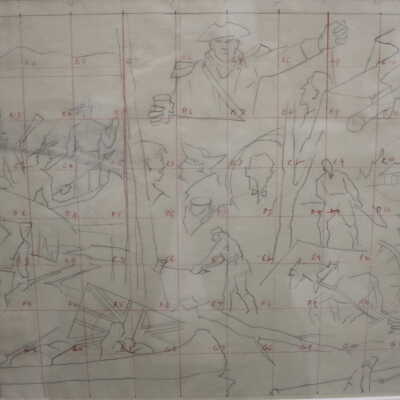

Tribute to Vermont (study 3)
Name/Title
Tribute to Vermont (study 3)
Description
The drawing is on brown paper. On the entire picture there is a grid. Numbers line the vertical axis, they go up to 25 in red ink then start over from 1 in yellow ink. On the vertical axis there are letters up to G. When these two axis meet they create a square inch box; these boxes are all along the picture. In the far left corner there is a scene of Native Americans paddling a canoe, and to their left is supposedly Samuel de Champlain. To the right of the Native American scene is a picture of a man with his fist raised wearing a colonial hat. Below him there is a man chopping wood and two horses pulling something. To the right of these scenes the sketches get darker in shade. There is a picture of a church with hands clasped in a prayer position. To the churches right there is a picture of a man and woman holding each other. Under them is a man holding a piece of paper, and below this man is a picture of the state house. To the right of the state house there is a large scene of sap collecting. Two trees frame this scene. To the right and a bit above that scene there is the front of a building, below the building there is a group of people, some of them are waving their hands. Next to the group of people and the building, on the right, there is a tree, to the right of the tree begins a new scene. This scene is of farmers. Miking cows, taking care of horses. Above the farm scene there is a granite workers scene. A man waving his hand to another man working in the granite quarry. To the right of these two scenes is another tree. To the right of that tree, in the upper right corner is a scene of a college graduation. Below that is a drawing of people skiing.
Acquisition
Accession
2016.39
Artwork Details
Medium
Pencil
Made/Created
Artist Information
Sample, Paul Starrett (1896-1974)
Artist
Date made
2016
Dimensions
Height
14-1/8 in
Length
55-3/4 in
Entry/Object ID
2016.39.4
Type of Drawing
Context
When National Life laid the cornerstone of its headquarters on the ridge overlooking Montpelier in 1958, their CEO approached well-known-muralist Paul Sample to create an iconic work of art to evoke the past, present, and future of Vermont as a centerpiece of the new structure. Sample worked closely with National Life to choose scenes and topics that reflected both Vermont's story and that of the company's rich Vermont roots. As he got closer to a final design, Sample produced scale drawings, called cartoons, of the mural in both pencil and paint for company approval. When he was ready to transfer the design to the full eight by fifty-foot canvas, he partitioned the final cartoon into numbered blocks to ease the enlargement of scenes. Notice how the composition and content of the mural changed from the bottom sketch to the top working design.
Paul Starrett Sample (September 14, 1896 – February 26, 1974) was an American artist who portrayed life in New England in the middle of the 20th Century with a style that showed elements of "Social Realism and Regionalism."
Sample was born in Louisville, Kentucky in 1896. After having moved across the country with his family on several occasions, Sample attended Dartmouth College in Hanover, New Hampshire. There he studied architecture and graduated in 1921 after a year in the Naval Reserve during World War I. While visiting his brother, Donald, at a sanatorium in Saranac Lake, New York, Sample contracted tuberculosis. He stayed for treatment of that disease in Saranac Lake for four years. There he met Sylvia Howland, whom he married in 1928.
At Saranac Lake, Sample studied drawing and painting under Jonas Lie. He then studied at the Art Students League of Los Angeles, and the Otis Art Institute in Los Angeles, California. There his work reflected social issues connected with the Great Depression with two noted paintings in 1931. In 1926 Sample joined the faculty of the University of Southern California in the school of architecture, where he remained until 1938. In 1938, he returned to New Hampshire to become the artist in residence at Dartmouth College, a position which he held until 1962. In addition to his social and regional paintings, Sample produced artwork for various magazines during World War II.
Paul Starrett Sample (September 14, 1896 – February 26, 1974) was an American artist who portrayed life in New England in the middle of the 20th Century with a style that showed elements of "Social Realism and Regionalism."
Sample was born in Louisville, Kentucky in 1896. After having moved across the country with his family on several occasions, Sample attended Dartmouth College in Hanover, New Hampshire. There he studied architecture and graduated in 1921 after a year in the Naval Reserve during World War I. While visiting his brother, Donald, at a sanatorium in Saranac Lake, New York, Sample contracted tuberculosis. He stayed for treatment of that disease in Saranac Lake for four years. There he met Sylvia Howland, whom he married in 1928.
At Saranac Lake, Sample studied drawing and painting under Jonas Lie. He then studied at the Art Students League of Los Angeles, and the Otis Art Institute in Los Angeles, California. There his work reflected social issues connected with the Great Depression with two noted paintings in 1931. In 1926 Sample joined the faculty of the University of Southern California in the school of architecture, where he remained until 1938. In 1938, he returned to New Hampshire to become the artist in residence at Dartmouth College, a position which he held until 1962. In addition to his social and regional paintings, Sample produced artwork for various magazines during World War II.